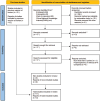Association between vitamin D receptor gene polymorphisms and genetic susceptibility to benign prostatic hyperplasia: A systematic review and meta-analysis
- PMID: 38428858
- PMCID: PMC10906597
- DOI: 10.1097/MD.0000000000037361
Association between vitamin D receptor gene polymorphisms and genetic susceptibility to benign prostatic hyperplasia: A systematic review and meta-analysis
Abstract
Background: Benign prostatic hyperplasia (BPH) is one of the global public health challenges due to the complexity of its mechanisms of occurrence. Many studies have suggested that vitamin D receptor gene polymorphisms are associated with BPH susceptibility. Still, their conflicting findings need to be analyzed in aggregate to gain a better understanding.
Methods: We identified 10 trials involving 1539 BPH cases and 1915 controls through a systematic search of Embase using, data obtained from the Web of Science, PubMed, and China Knowledge Network databases as of December 31, 2021. A meta-analysis was performed to investigate the association between 4 constant polymorphisms of this associated vitamin D receptor gene (Fok-1, Bsm-1, Taq-1, and Apa-1) and BPH risk.
Results: In the overall population analysis, a significant positive association with BPH risk was found only in the Taq-1 variant (P < .001). Of these, the pure-hybrid model (95% confidence interval [CI] = 1.384-3.196), the heterozygous model (95% CI = 1.207-2.021), the dominant model (95% CI = 1.312-2.133) and the allelic inheritance model (95% CI = 1.205-1.730) showed low heterogeneity. In subtype analyses, Bsm-1 variants showed a significant association with BPH risk for both the recessive (95% CI = 0.100-0.943, P = .039) and over-dominant (95% CI = 1.553-3.100, P = 0) models in the Caucasian population, and for the recessive (95% CI = 1.242-3.283, P = .039) and over-dominant (95% CI = 0.281-0.680, P = 0) models in the Asian population. In addition, a high degree of heterogeneity was found in the subgroup analysis of the association between Fok-1 variants and BPH risk.
Conclusion: Overall, there is an association between vitamin D receptor polymorphisms and BPH risk. Identification of BPH susceptibility by vitamin D receptor gene polymorphisms has potential.
Copyright © 2024 the Author(s). Published by Wolters Kluwer Health, Inc.
Conflict of interest statement
The authors have no conflicts of interest to disclose.
Figures



Similar articles
-
Meta-analysis of vitamin D receptor gene polymorphisms and benign prostatic hyperplasia risk.Mol Biol Rep. 2014 Oct;41(10):6713-7. doi: 10.1007/s11033-014-3554-2. Epub 2014 Jul 3. Mol Biol Rep. 2014. PMID: 24990700
-
Association of genetic variants of the vitamin D receptor (VDR) gene (Fok-I, Taq-I and Bsm-I) with susceptibility of benign prostatic hyperplasia in a North Indian population.Asian Pac J Cancer Prev. 2010;11(4):1005-8. Asian Pac J Cancer Prev. 2010. PMID: 21133615
-
Systematic review and meta-analysis of candidate gene association studies of benign prostate hyperplasia.Syst Rev. 2022 Apr 5;11(1):60. doi: 10.1186/s13643-022-01914-7. Syst Rev. 2022. PMID: 35382870 Free PMC article.
-
[Relationship between vitamin D receptor gene Fok I polymorphisms and benign prostatic hyperplasia complicated by histological prostatitis].Zhonghua Nan Ke Xue. 2011 Oct;17(10):880-3. Zhonghua Nan Ke Xue. 2011. PMID: 22049788 Chinese.
-
Association between vitamin D receptor polymorphisms and periodontitis: a meta-analysis.J Periodontol. 2012 Sep;83(9):1095-103. doi: 10.1902/jop.2011.110518. Epub 2011 Dec 19. J Periodontol. 2012. PMID: 22181683
References
-
- Lerner LB, McVary KT, Barry MJ, et al. . Management of lower urinary tract symptoms attributed to benign prostatic hyperplasia: AUA GUIDELINE PART I—initial work-up and medical management. J Urol. 2021;206:806–17. - PubMed
-
- Devlin CM, Simms MS, Maitland NJ. Benign prostatic hyperplasia—what do we know? BJU Int. 2021;127:389–99. - PubMed
-
- Qian XQ, Xu D, Liu HL, et al. . Genetic variants in 5p13.2 and 7q21.1 are associated with treatment for benign prostatic hyperplasia with the alpha-adrenergic receptor antagonist. Aging Male. 2017;20:250–6. - PubMed
-
- AlChalabi R, Wali MH, Al-Ugaili DN, et al. . Association between single nucleotide polymorphisms of vitamin D receptor gene and diabetes with progression of benign prostatic hyperplasia. Ann Trop Med Public Health. 2020;23:444–54.
Publication types
MeSH terms
Substances
LinkOut - more resources
Full Text Sources
Medical

